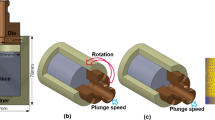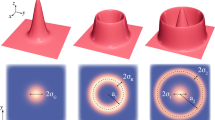Abstract
The grain structure of a weld seam influences its susceptibility to hot cracking during the welding process. The previously derived explicit analytical expressions allow for the accurate prediction of both the morphology of the grain structure and the grain size in a wide range of processing parameters. This model is now combined with the pressure balance model of Rappaz, which describes the formation of hot cracks by the balance between solidification shrinkage and thermomechanical deformation. The combination of the two models allows for the description of the impact of the welding parameters on the strain rate limit that a laser welded seam can withstand without the formation of hot cracks. It reveals that the absorbed line energy per depth is the key parameter to influence the value of this limit. The model was validated for the case of laser beam welding of the technical aluminum alloy AA6016. The calculated critical strain rates agree well with the experimentally determined critical strain rates measured by means of digital image correlation.





Similar content being viewed by others
Change history
05 November 2019
In the original article the indefinite integral sign of the solidification path is missing in Eq. [5].
Notes
The values of Δpd, Δpc, Δpsh, and Δpε are positive in case of a pressure drop.
References
N. N. Rykalin and C. Fritzsche: Berechnung der Wärmevorgänge beim Schweissen, Verlag Technik, Berlin, 1957.
C. Hagenlocher, F. Fetzer, D. Weller, R. Weber and T. Graf: Materials & Design, 2019, vol.174, p. 107791.
Z. Tang and F. Vollertsen: Welding in the World, 2014, vol.58, pp. 355–366.
N. Coniglio and C. E. Cross: International Materials Reviews, 2013, vol.58, pp. 375–397.
L. J. Barker: Trans. ASM, 1950, vol.42, p. 347.
M. Rappaz, J.-M. Drezet and M. Germaud: Metallurgical and Materials Transactions A, 1999, vol.30, pp. 449–455.
C. Hagenlocher, P. Stritt, R. Weber and T. Graf: Optics and Lasers in Engineering, 2018, vol.100, pp. 131–140.
N. Bakir, V. Pavlov, S. Zavjalov, S. Volvenko, A. Gumenyuk and M. Rethmeier: Welding in the World, 2019, vol.63, pp. 435–441.
V. Quiroz, A. Gumenyuk and M. Rethmeier: Journal of strain analysis, 2012, vol.47, pp. 587–599.
C. Gollnow and T. Kannengießer: Welding in the World, 2013, vol.57, pp. 277–284.
U. Feurer: Giessereiforschung, 1976, vol.28, pp. 75–80.
W. S. Pellini and W. R. Applett: Welding Journal, 1954, vol.33, pp. 83–90.
W. S. Pellini: Foundry, 1952, vol.80, pp. 125–199.
N. Coniglio and C. E. Cross: Metallurgical and Materials Transactions A, 2009, vol.40, pp. 2718–2728.
C. Hagenlocher, D. Weller, R. Weber and T. Graf: Science and Technology of Welding and Joining, 2019, vol.24, pp. 313–319.
D. Weller, C. Hagenlocher, T. Steeb, R. Weber and T. Graf: Procedia CIRP, 2018, vol.74, pp. 430–433.
N. Coniglio, C. E. Cross, T. Michael and M. Lammers: Welding Journal, 2008, vol.87, pp. 237–247.
E. Cicala, G. Duffet, H. Andrzejewski, D. Grevey and S. Ignat: Materials Science and Engineering A, 2005, vol.395, pp. 1–9.
J. Wang, H.-P. Wang, X. Wang, H. Cui and F. Lu: Optics & Laser Technology, 2015, vol.66, pp. 15–21.
Y. Zhang, F. Lu, H. Cui, Y. Cai, S. Guo and X. Tang: The International Journal of Advanced Manufacturing Technology, 2016, vol.86, pp. 2895–2904.
M. Holzer, K. Hofmann, V. Mann, F. Hugger, S. Roth and M. Schmidt: Physics Procedia, 2016, vol.83, pp. 463–471.
H. Wei, J. S. Chen, H.-P. Wang and B. E. Carlson: Journal of Laser Applications, 2016, vol.28, p. 22405.
P. Stritt, R. Weber, T. Graf, S. Mueller, and J.-P. Weberpals: Proc. of ICALEO’12, 2012.
H. Langrieger, F. Krafft, M. Mensinger, and F. Oefele: Journal of Laser Applications, 2016, vol. 28, p. 022414.
J.-M. Drezet and D. Alleheaux: Hot Cracking Phenomena in Welds II, 2008, Springer, Berlin, pp. 19–38.
M. Rappaz, P.D. Grasso, V. Mathier, J.M. Drezet, and A. Jacot: Proc. of TMS, 2004, pp. 179–90.
S. Kou: Welding Metallurgy, 2nd ed, John Wiley & Sons, Hoboken, 2003.
J. Kozeny: Proc. Class I, 1927, Royal Academy of Science, Vienna, vol. 136, pp. 271–306.
P. C. Carman: Trans. Inst. Chem. Eng, 1937, vol.15, pp. 150–166.
J.F. Grandfield, C.J. Davidson, and J.A. Taylor: Contin. Cast., 2000, vol. 24, pp. 205–210.
E. Scheil: Zeitschrift für Metallkunde, 1942, vol.34, pp. 70–72.
J.-O. Andersson, T. Helander, L. Höglund, P. Shi and B. Sundman: Calphad, 2002, vol.26, pp. 273–312.
C. Kammer: Aluminium Taschenbuch, 15th ed, Aluminium Verlag, Düsseldorf, 1998.
T. Magnusson and L. Arnberg: Metallurgical and Materials Transactions A, 2001, vol.32, pp. 2605–2613.
A. Gouffé: Revue D’Optique Théorique et Instrumentale, 1945, vol.24, pp. 1–10.
M. Kutsuna, K. Shido and T. Okada: Proc. of First International Symposium on High-Power Laser Macroprocessing, 2003, pp. 230–35.
Standard: SEP 1220-3, 2011.
D. Weller, C. Bezençon, P. Stritt, R. Weber and T. Graf: Physics Procedia, 2013, vol. 41, pp. 164–168.
Acknowledgments
This work was partly supported by Constellium and funded in part by the Deutsche Forschungsgemeinschaft (DFG, German Research Foundation)—389369540.
Author information
Authors and Affiliations
Corresponding author
Additional information
Publisher's Note
Springer Nature remains neutral with regard to jurisdictional claims in published maps and institutional affiliations.
Manuscript submitted April 30, 2019.
Rights and permissions
About this article
Cite this article
Hagenlocher, C., Weller, D., Weber, R. et al. Analytical Description of the Influence of the Welding Parameters on the Hot Cracking Susceptibility of Laser Beam Welds in Aluminum Alloys. Metall Mater Trans A 50, 5174–5180 (2019). https://doi.org/10.1007/s11661-019-05430-7
Received:
Published:
Issue Date:
DOI: https://doi.org/10.1007/s11661-019-05430-7




